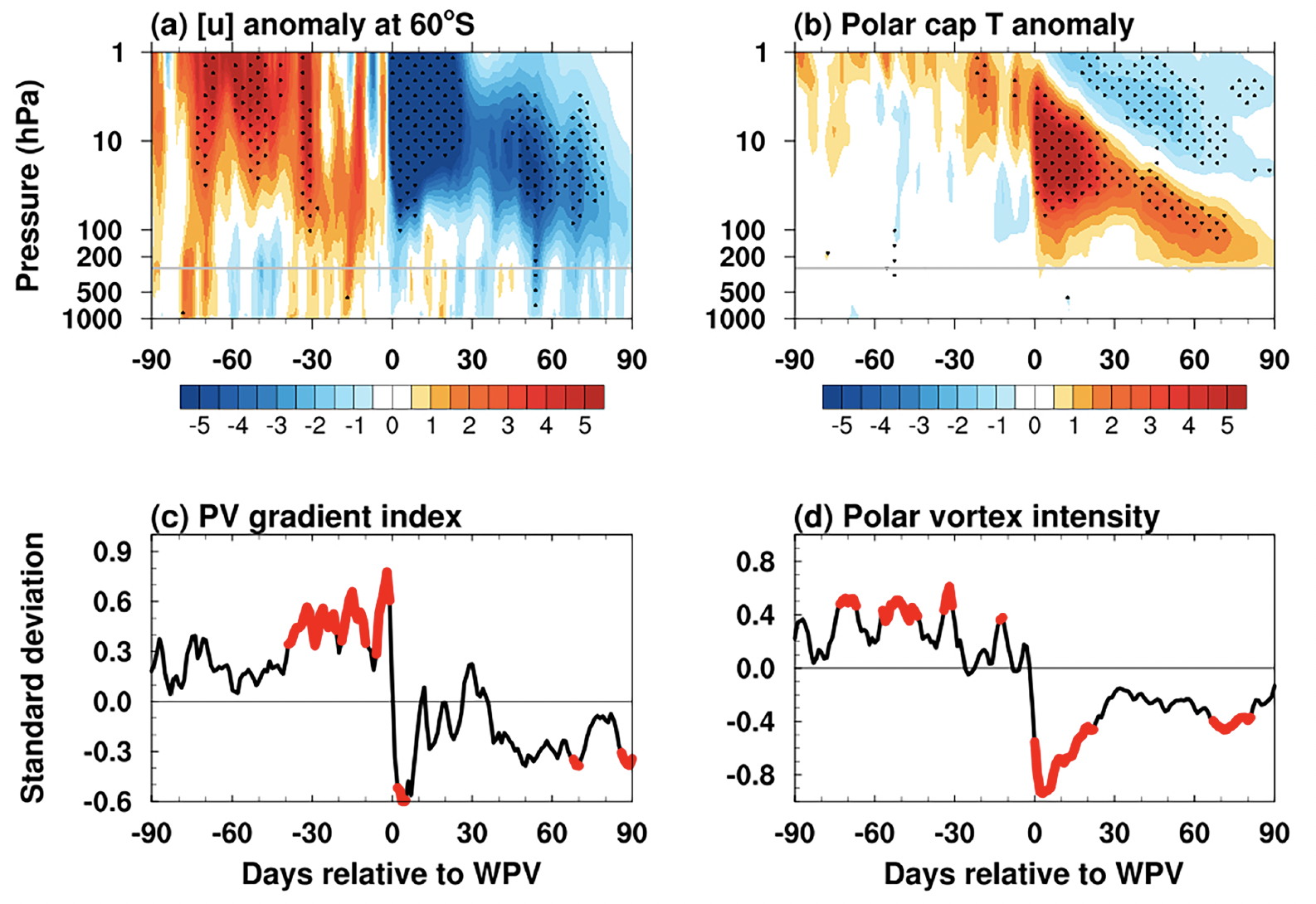In the Northern Hemisphere (NH) winter, the stratospheric polar vortex is subject to strong forcing from vertically propagating planetary waves originating in the troposphere, leading to intense stratospheric sudden warming events (SSWs). These events cause dramatic intraseasonal variability in the polar vortex, with the polar night jet even reversing to easterly winds. In contrast, the Southern Hemisphere (SH) has a less pronounced midlatitude land-sea contrast, resulting in weaker tropospheric planetary wave forcing. Consequently, strong SSW events are rare in the SH stratosphere, with only one recorded occurrence in September 2002.
However, the SH polar vortex also experiences significant intraseasonal weakening during winter, characterized by sudden warming in the polar cap region and weakening of the polar night jet. These events, known as Weak Polar Vortex events (WPVs), also have important impacts on tropospheric circulation and weather and climate. While research on NH SSWs is extensive, studies on SH WPVs are relatively limited, especially regarding the role of vortex preconditioning in the occurrence of WPVs. Recently, a collaborative study by doctoral candidate Pengkun Yang, Professor Ming Bao, Professor Xuejuan Ren from Nanjing University, and Associate Professor Yan Xia from Beijing Normal University revealed the internal stratospheric dynamics underlying SH WPVs. The findings were published in the latest issue of the American Meteorological Society's journal, Journal of Climate.
The study found that the occurrence of SH WPVs is closely related to the state of the stratospheric polar vortex prior to the events (Figure 1). Within 80 days before the onset of WPVs, the polar night jet in the stratosphere shifts poleward, coinciding with an enhanced meridional potential vorticity (PV) gradient along the vortex edge. This anomalous state of the stratospheric polar vortex provides favorable conditions for the upward propagation of planetary waves, leading to the weakening of the polar vortex. Approximately 84% of WPVs are preceded by significant stratospheric vortex conditions. Moreover, about 36% of WPVs are triggered solely by these preconditioning effects, without significant anomalous tropospheric planetary wave forcing. This indicates that vortex preconditioning can play a dominant role in some SH WPVs, especially when tropospheric planetary wave forcing is weak.
Compared to the NH, the preconditioning stage of SH WPVs lasts much longer, typically 2–3 months, whereas in the NH, it usually persists for less than 40 days. Additionally, SH WPVs more frequently experience minor warming disturbances of planetary wave one in the middle and upper stratosphere before their occurrence. Using a multiple linear regression model, the study quantified the contributions of stratospheric internal dynamics and tropospheric planetary wave forcing to WPVs. The results showed that preconditioning effects contributed about 41% and 65% to the 10-day zonal wind deceleration during the two strong WPVs in 2002 and 2019, respectively.

Fig. 1. Composite time-height cross sections of (a) zonal-mean zonal wind anomalies at 60°S and (b) area-weighted temperature anomalies over 60°-90°S. (c), (d) represent the temporal evolutions of standardized ![]() and vortex intensity index, respectively. Lag=0 on the abscissa (days) denotes the onset date of WPVs. Stippled areas indicate statistical significance at the 95% level according to the Student's t test. Thick red lines in (c) and (d) highlight that the composite anomalies are significant at the 95% confidence level. A horizontal gray line in (a) and (b) represents the approximate tropopause level (~270 hPa).
and vortex intensity index, respectively. Lag=0 on the abscissa (days) denotes the onset date of WPVs. Stippled areas indicate statistical significance at the 95% level according to the Student's t test. Thick red lines in (c) and (d) highlight that the composite anomalies are significant at the 95% confidence level. A horizontal gray line in (a) and (b) represents the approximate tropopause level (~270 hPa).
This study is the first to systematically reveal the role of vortex preconditioning in SH WPVs, emphasizing the importance of internal stratospheric dynamics in Antarctic polar vortex variability. The findings are significant for understanding the dynamics of the SH polar vortex and its impacts on global climate.
The study, along with a series of recent works by the research group (Yang et al. 2023a; 2023b; 2024; 2025), suggests that vortex preconditioning is a universal rule in the dynamics of extratropical stratosphere-troposphere coupling.
References:
Yang, P., M. Bao, Y. Xia, and X. Ren, 2025: The Role of Vortex Preconditioning in the Occurrence of Antarctic Weak Polar Vortex Events. J. Climate, 38, 1319–1332, https://doi.org/10.1175/JCLI-D-24-0159.1
Yang, P., M. Bao, and X. Ren, 2024: Preconditioned stratospheric modulation on the occurrence of stratospheric final warmings. Geophysical Research Letters, 51, e2023GL107294.
https://doi.org/10.1029/2023GL107294
Yang, P., M. Bao, and X. Ren, 2023b: Influence of preconditioned stratospheric state on the surface response to displacement and split sudden stratospheric warmings. Geophysical Research Letters, 50, e2023GL103992. https://doi.org/10.1029/2023GL103992
Yang, P., M. Bao, X. Ren, and X. Tan, 2023a: The Role of Vortex Preconditioning in Influencing the Occurrence of Strong and Weak Sudden Stratospheric Warmings in ERA5 Reanalysis. J. Climate, 36, 1197–1212, https://doi.org/10.1175/JCLI-D-22-0319.1
